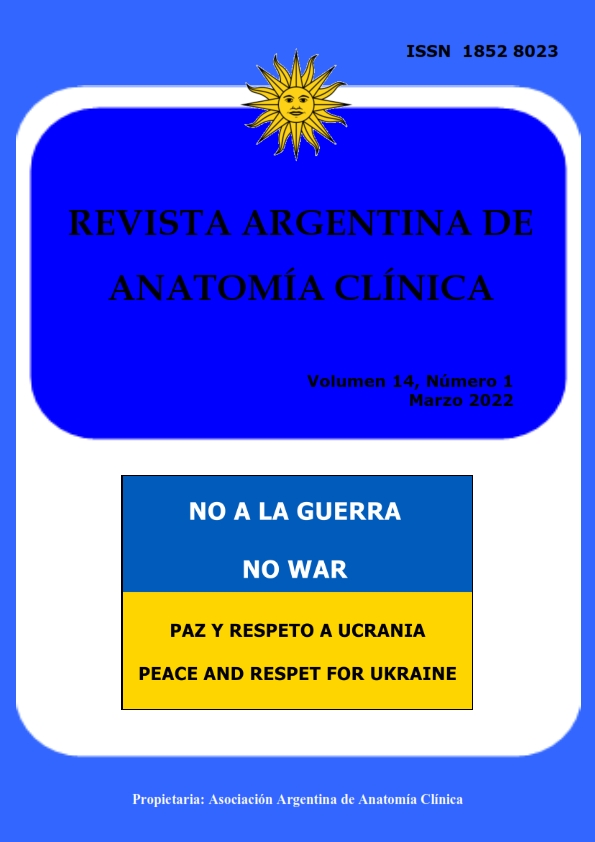Landmarks for the facial vein within the carotid triangle and implications in carotid surgery.
DOI:
https://doi.org/10.31051/1852.8023.v14.n1.36834Keywords:
carotid endarterectomy; internal carotid artery; common carotid artery; veins; anatomy.Abstract
Introduction: In carotid surgery, proper anatomical knowledge is essential to reduce surgical time and complications. The aim of the present study is to provide landmarks for the localization of the facial vein in respect of the carotid bifurcation and its anatomical characteristics. Materials and methods: 20 carotid triangles of formalin fixed adult cadavers were dissected. The following measurements were recorded. The “carotid axis” was defined and measured as the distance in cm following the longitudinal axis of the common and internal carotid artery from the clavicle to the upper edge of the posterior belly of the digastric (L1). Distance of the carotid bifurcation within the carotid axis (L2). Distance of the facial vein within the carotid axis (L3). Distance between the facial vein and the carotid bifurcation (L4). Also, we recorded the number of tributaries received by the facial vein and the exit site. Results: L1 mean 14 cm (range 9.6-15); L2 Mean 10.1 cm (range 7.5-12.5); L3 Average 8.6 cm (range 5-12.6). L4 Average 1.3 cm (0.2-3.1). Discussion: In most of the cases studied, the facial vein was found below the carotid bifurcation, however the distance between the two was 1.3cm on average, so we can say that they are close to each other. Conclusion: The proximity between the facial vein and the carotid bifurcation found in the present study allows us to conclude that the facial vein is potentially useful as an anatomical landmark to locate the carotid bifurcation in carotid surgery. Also, due to its proximity, the facial vein can be injured and thus lead to complications during this procedure.
Downloads
References
Bertha A, Rabi S 2011. Anatomical Variations in Termination of Common Facial Vein. J Clini Res, 5(1): 24-7.
Choudhry R, Tuli A, Choudhry S. 1997. Facial vein terminating in the external jugular vein. An embryologic interpretation. Surg Radiol Anat, 19: 73-7.
D'Silva S, Pulakunta T, Kumar Potu B. 2008. Termination of the facial vein into the external jugular vein: an anatomical variation. JVasc Bras, 7(2):174-175.
Dehn TCB, Taylor GW. 1983. Cranial and cervical nerve damage associated with carotid endarterectomy. Br J Surg, 70: 365-368.
Doig D, Tuner EL, Dobson J, Featherstone RL, de Borst GJ, Brown MM, Richards T. 2014. Incidence, Impact, and Predictors of Cranial Nerve Palsy and Haematoma Following Carotid Endarterectomy in the International Carotid Stenting Study. Eur J Endovasc Surg, 48: 498-504.
Ferreira-Arquez H. Facial. 2018. Vein Variation: a Cadaveric Study. International archives of Medicine section: human anatomy, 11(6): 1-7.
Gelebart HA, Moore WS. 1991. Carotid endarterectomy: Current status. Curr Probl Surg, 3:183–192.
Gusmao LCB, De Sousa-Rodrigues CF, Gonzalez FSG, Pereira LMT. 2006. Drenaje de las Venas Facial, Lingual y Tiroidea Superior en el Hombre. Int. J. Morphol, 24(4): 685-688.
Hertzer NR, Feldman BJ, Beven EG, Tucker HM. 1980. A prospective study of the incidence of injury to the cranial nerves during carotid endarterectomy. Surg Gynecol Obstet, 150: 781-784.
Kakisis JD, Antonopoulos CN, Mantas G, Moulakakis KG, Sfyroeras G, Geroulakos G. 2017. Cranial Nerve Injury After Carotid Endarterectomy: Incidence, Risk Factors, and Time Trends. Eur J Endovasc Surg, 53: 320-335.
Latarjet M, Ruiz-Liard A. 2004. Anatomía Humana. 4ª edición, Buenos Aires: Editorial Panamericana, pag: 1040-1043.
Madeira MC, Hetem, S. 1917. Dados Morfológicos sobre as veias retromandibular, facial, facial comum, jugular anterior e tronco tireo-lingo-facial em fetos e crianças. Arg. Anat. Antropol, 35: 211-242.
Naylor AR, Ricco JB, de Borst GJ, Debus J, de Haro A, Halliday G, Hamilton J, Kakisis S, Kakkos S, Lepidi H.S, Markus D.J, McCabe J, Roy H, Sillesen, J.C, Van den Berg F, Vermassen. 2018. Management of Atherosclerotic Carotid and Vertebral Artery Disease: 2017 Clinical Practice Guidelines of the European Society for Vascular Surgery (ESVS). Eur J Endovasc Surg, 55: 44.
Nunn DB. 1975. Carotid endarterectomy: An analysis of 234 operative cases. Ann Surg, 182: 733–738.
Ranson JHC, Imparato AM, Clauss RH, Reed GE, Hass WK. 1969. Factors in the mortality and morbidity associated with surgical treatment of cerebrovascular insufficiency. Circulation, 39(5 Suppl I): I269–I274.
Rouviere H, Delmas A. 2005. Anatomía Humana Descriptiva, Topográfica y Funcional, Tomo I. 11 edición. Barcelona, Masson, pag: 253-254.
Rutherford RB ed. 1993. Atlas of Vascular Surgery. En: Basic Techniques and Exposures. Philadelphia. W.B. Saunders Company, pag: 237-241.
Shima H, Von Luedinghausen M, Ohno K, Michi K. 1998. Anatomy of microvascular anastomosis in the neck. Plast. Reconstr. Surg, 101(1): 33-41.
Standring S. (2008). Gray’s anatomy. The anatomical basis of clinical practice, 40th edition. Churchill livingstone Elsevier, United Kingdom, pag: 451, 492.
Sundt TM, Sandok BA, Whisnant JP. 1975. Carotid endarterectomy: Complications and pre-operative assessment of risk. Mayo Clin Proc, 50:30151–306.
Downloads
Published
How to Cite
Issue
Section
License
Copyright (c) 2022 Alejandra Mansilla Lizardi, Sofía Martinez Ventura, Sofía Mansilla Rud, Matilde Lissarrague Blanco , Alejandro Russo Cousté

This work is licensed under a Creative Commons Attribution-NonCommercial 4.0 International License.
Authors retain copyright and grant the journal right of first publication with the work simultaneously licensed under a Creative Commons Attribution License that allows others to share the work with an acknowledgement of the work's authorship and initial publication in this journal. Use restricted to non commercial purposes.
Once the manuscript has been accepted for publications, authors will sign a Copyright Transfer Agreement to let the “Asociación Argentina de Anatomía Clínica” (Argentine Association of Clinical Anatomy) to edit, publish and disseminate the contribution.



